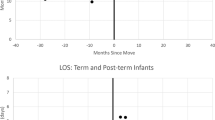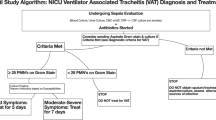Abstract
Objective:
A mandate exists that all level III neonatal intensive care units (NICUs) provide a means to assess and follow their high-risk neonates after discharge. However, no standardized guidelines exist for the follow-up services provided. To determine trends of structure and care provided in NICU follow-up clinics in both the academic and private clinical setting.
Study Design:
We sent an Internet survey to NICU follow-up clinic directors at both academically affiliated and private centers. This study received institutional review board exemption.
Result:
We received 89 surveys from academic institutions and 94 from private level III follow-up programs. These responses represent 55% of academic programs and 40% of private programs in the United States. Similar to academic institutions, 18% of private NICU follow-up clinics provide primary care services to patients. In both settings, the hospital supports 60% of the funding required for clinic activities. Forty-five percent of NICU graduates seen in both private and academic follow-up clinics have public aid as their primary insurance. Eighty-five percent of NICUs in both settings have guidelines outlining requirements for referrals to the follow-up clinic. Academic programs find feeding difficulties the most difficult, whereas private programs find bronchopulmonary dysplasia and feeding difficulties equally as difficult.
Conclusion:
The care and struggles of NICU follow-up clinics are similar in both the academic affiliated and private settings. Similar referrals, clinical evaluation and medical care occur with varying struggles.
This is a preview of subscription content, access via your institution
Access options
Subscribe to this journal
Receive 12 print issues and online access
$259.00 per year
only $21.58 per issue
Buy this article
- Purchase on Springer Link
- Instant access to full article PDF
Prices may be subject to local taxes which are calculated during checkout




Similar content being viewed by others
References
Kuppala VS, Tabangin M, Haberman B, Steichen J, Yolton K . Current state of high-risk infant follow-up care in the United States: results of a national survey of academic follow-up programs. J Perinatol 2012; 32: 293–298.
Vohr B, O’Shea M, Wright L . Longitudinal multicenter follow-up of high-risk infants: Why, Who, When, and What to Asses. Sem Perinatol 2003; 27: 333–342.
Faranoff A, Hack M, Walsh M . The NICHD Neonatal Research Network: changes in practice and outcomes during the first 15 years. Sem Perinatol 2003; 27: 281–287.
American Academy of Pediatrics Committee on Fetus and Newborn. Hospital Discharge of the high-risk neonate: Committee on Fetus and Newborn. Pediatrics 2008; 122: 2008–2174.
Ballantyne M, Stevens B, Guttmann A, Willan AR, Rosenbaum P . Maternal and infant predictors of attendance at neonatal follow-up programmes. Child Care Health Dev 2013 doi:10.1111/cch.12015 (e-pub ahead of print).
Broyles R, Tyson J, Heyne E, Heyne R, Hickman J, Swint M et al. Comprehensive follow-up care and life-threatening illnesses among high-risk infants. J Am Med Assoc 2000; 284: 2070–2076.
Verma R, Sridhar S, Spitzer A . Continuing care of NICU graduates. Clin Pediatr 2003; 42: 299–315.
Ballantyne M, Stevens B, Guttmann A, Willan A, Rosenbaum P . Transition to neonatal follow-up programs. J Perinatol Neonatal Nurs 2012; 26: 90–98.
Walker K, Holland A, Halliday R, Badaw N . Which high-risk infants should we follow-up and how should we do it? J Paediatr Child Health 2012; 48: 789–793.
Cho J, Lee J, Ah Youn Y, Kim S, Kim S, Sung K . Parental concerns about their premature infants’ health after discharge from the neonatal intensive care unit: a questionnaire survey for anticipated guidance in a neonatal follow-up clinic. Korean J Pediatr 2012; 55: 272–279.
Ritchie S . Primary care of the premature infant discharged form the neonatal intensive care unit. Am J Matern Child Nurs 2002; 27: 76–85.
Lantos J . Cruel Calculus: why saving premature babies is better business than helping them thrive. Health Aff 2010; 29: 2114–2117.
Berman S, Rannie M, Moore L, Elias E, Dryer L, Jones D . Utilization and costs for children who have special health care needs and are enrolled in a hospital-based comprehensive primary care clinic. Pediatrics 2005; 115: e637–e642.
Author information
Authors and Affiliations
Ethics declarations
Competing interests
The authors declare no conflict of interest.
Rights and permissions
About this article
Cite this article
Bockli, K., Andrews, B., Pellerite, M. et al. Trends and challenges in United States neonatal intensive care units follow-up clinics. J Perinatol 34, 71–74 (2014). https://doi.org/10.1038/jp.2013.136
Received:
Revised:
Accepted:
Published:
Issue Date:
DOI: https://doi.org/10.1038/jp.2013.136
Keywords
This article is cited by
-
Social disparities negatively impact neonatal follow-up clinic attendance of premature infants discharged from the neonatal intensive care unit
Journal of Perinatology (2020)
-
Telemedicine, a tool for follow-up of infants discharged from the NICU? Experience from a pilot project
Journal of Perinatology (2020)
-
Development of a Multidisciplinary Medical Home Program for NICU Graduates
Maternal and Child Health Journal (2020)
-
Health-care spending and utilization for children discharged from a neonatal intensive care unit
Journal of Perinatology (2018)
-
Newborn intensive care survivors: a review and a plan for collaboration in Texas
Maternal Health, Neonatology and Perinatology (2015)



